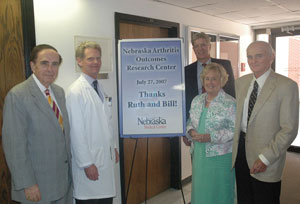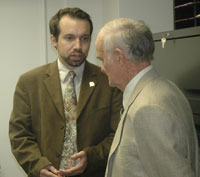 |
Celebrating the opening of the Nebraska Arthritis Outcomes Research Center last week were, from left, UNMC Chancellor Harold M. Maurer, M.D., Kevin Garvin, M.D., James O’Dell, M.D., Ruth Scott and Bill Scott. |
Two of UNMC’s biggest supporters, Ruth and Bill Scott, were on campus last week to participate in a ribbon-cutting ceremony for the Nebraska Arthritis Outcomes Research Center located on the third floor of Poynter Hall.
The center, made possible by a major donation by the Scotts, was established to conduct studies, which will provide a better understanding of arthritis through detailed analysis of the many determinants used to predict outcomes for arthritis sufferers.
“Information is powerful,” said Ruth Scott, “and that’s what this new center is all about — finding answers to how we can better manage arthritis and come up with the best possible outcomes. Bill and I have seen three generations of our families suffer from arthritis. We believe this new center has the potential to truly make a difference for future generations. We are honored to be associated with it.”
|
Also, audio clips about the new center from Chancellor Maurer, Dr. Jim O’Dell and Dr. Kevin Garvin can be heard by clicking on each physician’s name. |
The Scotts are both graduates of the University of Nebraska-Lincoln. Bill Scott is a former vice president of Berkshire Hathaway. Ruth Scott is a bridge instructor and founder of the Omaha Bridge Studio.
The center marks the third major gift the Scotts have made to the medical center. In 2003, their contribution to the Durham Research Center established the Ruth and Bill Scott Neuroscience Research Laboratories located on the third floor. In 2006, they made the largest gift to the University of Nebraska Foundation in support of the Michael F. Sorrell Center for Health Science Education. Construction of the Sorrell Center, which will serve as home to the UNMC College of Medicine, will be completed in 2008.
The Nebraska Arthritis Outcomes Research Center will be headed by two of UNMC’s leading physicians — James O’Dell, M.D., professor of internal medicine and chief of the rheumatology and immunology section, and Kevin Garvin, M.D., professor and chairman of orthopaedic surgery.
“The Scotts’ generous gift solidifies the ongoing collaborative efforts between rheumatology and orthopaedics,” Dr. O’Dell said. “By working together and combining our expertise, we think we will be able to make a huge impact in the care of arthritis sufferers.”
“The Scotts are truly visionary people,” Dr. Garvin said. “They understand the value of research, and they realize that it can produce major dividends over the course of time. We can’t thank them enough for giving us this wonderful opportunity.”
Much of the day-to-day research in the Nebraska Arthritis Outcomes Research Center will be conducted by Ted Mikuls, M.D., associate professor in the rheumatology section of the department of internal medicine, and Kaleb Michaud, Ph.D., assistant professor, internal medicine.
 |
Kaleb Michaud, Ph.D., assistant professor of internal medicine, visits with Bill Scott about the Nebraska Arthritis Outcomes Research Center. |
Using a large national database of 30,000 patients from the National Surgical Quality Improvement Program database and through the Veterans Affairs hospitals, the researchers will explore determinants of poor surgical outcomes among U.S. veterans with arthritis undergoing joint replacement. Findings from this study will guide the development of future interventions aimed at improving surgical outcomes in arthritis sufferers, Dr. Garvin said.
Since being recruited to the Nebraska Arthritis Outcomes Research Center five months ago, Dr. Michaud has helped author or co-author five different papers for research journals and submitted 15 abstracts for scientific meetings.
“We are working with people all over the world,” said Dr. Michaud, a physicist who earned his Ph.D. from Stanford University and worked for several years with Fred Wolfe, M.D., of Wichita, Kan., one of the leading rheumatologists in the country. “The research opportunities are endless. One of our key roles is to figure out what studies make the most sense and what papers need to be written.
“Our center is interested in studying drug safety and trying to determine which drugs will be most beneficial to patients with the fewest side effects. There are six new biological drugs with five more ready to be launched as treatments for rheumatoid arthritis, but their average cost is $15,000 per year. So understanding their true effect or benefit becomes even more important for the patient and the paying society.”
The center is using the national databases to determine those arthritis patients who are the best candidates for joint replacement surgery.
“There aren’t clear-cut indicators for the use of total joint arthroplasty. Patient selection for this procedure is not a perfect science,” Dr. Mikuls said. “Right now, it’s using best judgment. We want to help physicians and patients make better, more informed decisions about total joint replacement. We need to be able to select the patients who will experience optimal benefit. Total joint replacement isn’t the only treatment for rheumatoid arthritis, and we need to know how it fits in with all these other therapies.”
Some of the criteria physicians use to decide whether joint replacement may be beneficial include the patient’s pain, function, structural damage, age, and what they expect to be able to do after surgery, Dr. Mikuls said, noting that about one-third of rheumatoid arthritis patients will undergo joint replacement surgery.
“We’d like to be able to provide some objectivity for physicians to make decisions,” Dr. Mikuls said. “The disease can be devastating. Thirty to 50 percent of working-age folks with rheumatoid arthritis will be work-disabled 10 to 20 years after having the disease. That’s huge, and we know the disease reduces life expectancy.”
The center will be exploring both osteoarthritis, the most common form of arthritis which affects up to 30 percent or more of the population, and rheumatoid arthritis, which is found in about 1 percent of people.
The Centers for Disease Control and Prevention (CDC) estimate that arthritis impacts the daily lives of more than 40 million Americans, including more than 500,000 Nebraskans. The annual cost of treating arthritis in the U.S. is nearly $64 billion. For Nebraska, this translates into annual costs of more than $320 million.
Another center study, led by rheumatologist Amy Cannella, M.D., and orthopaedic surgeon, Ed Fehringer, M.D., will examine the frequency and impact of chronic rotator cuff tears in patients with rheumatoid arthritis. Researchers will be recruiting UNMC and Omaha VA patients with rheumatoid arthritis. The patients will be examined using state-of-the-art imaging techniques including dynamic ultrasound. Findings from this study will allow researchers to better quantify the contribution of shoulder problems to poor outcomes in rheumatoid arthritis.